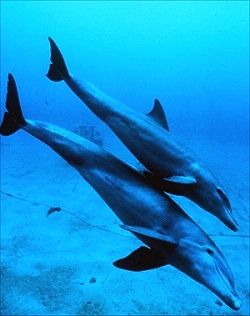Dolphin FAQ #2
Dolphin FAQ (page 2)
How deep can a dolphin dive?
The deepest dive ever recorded for a bottlenose dolphin was a 300 meters (990 feet). This was accomplished by Tuffy, a dolphin trained by the US Navy. Most likely dolphins do not dive very deep, though. Many bottlenose dolphins live in fairly shallow water. In the Sarasota Bay area, the dolphins spend a considerable time in waters that are less than 2 meters (7 feet) deep.
Other whale and dolphin species are able to dive to much greater depths even. The pilot whale (Globicephala melaena) can dive to at least 600 meters (2000 feet) and a sperm whale (Physeter macrocephalus) has been found entangled in a cable at more that 900 meters (500 fathoms) depth.
Recent studies on the behavior of belugas (Delphinapterus leucas) has revealed that they regularly dive to depths of 800 meters. The deepest dive recorded of a beluga was to 1250 meters. [1]
Do dolphins drink salt water?
Most dolphins live in the ocean and the ocean water is too salty for them to drink! If they would drink sea water, they would actually use more water trying to get rid of the salt than they drank in the first place. Most of their water comes from their food (fish and squid). Also, when they metabolize (burn) their fat, water is released in the process. Their kidneys are also adapted to retaining as much water as possible. Although they live in water, they live as desert animals with no direct source of drinkable water.
Dolphin mass strandings: Why?
If a single whale or dolphin strands, it usually is a very sick (and exhausted) animal. Such an animal often has some infections (pneumonia is almost always one of them) and a lot of parasites (worms in the nasal passages are very common). Sometimes these animals can be rehabilitated, but often they are so sick they won’t make it.
Some species of whales and dolphins occasionally strand in groups. A stranding of 2 or more animals is usually called a mass stranding. There are a number of theories that try to explain the occurrence of mass strandings. No theory can adequately explain all of them. In some cases it will be a combination of causes. The most common explanations are:
deep water animals (the species that most often are the victim of mass strandings) can not “see” a sloping sandy beach properly with its sonar. They detect the beach only when they are almost stranded already and they will panic and run aground. [2]
whales and dolphins may be navigating by the earth’s magnetic field. When the magnetic field is disturbed (this occurs at certain locations) the animals get lost and may run into a beach. [3]
in some highly social species, the group leader may be sick and wash ashore. The other members try to stay close and may strand with the group leader.[4]
when under severe stress or in panic, the animals may fall back to the behavior of their early ancestors and run to shore to find safety. [5]
Adapted from Dolphin FAQ maintained by Jaap van der Toorn (jaap@compuserve.com). sources:
[1] F.G. Wood (1993) Marine mammals and man. R.B. Luce, Inc., Washington. E.J. Slijper (1979) Whales, 2nd edition. Cornell University Press, Ithaca, NY. (Revised re-
[1] R.S. Wells, A.B. Irvine and M.D. Scott (1980) The social ecology of inshore odontocetes. In: L.M. Herman (ed.): Cetacean Behavior. Mechanisms & functions, pp. 263-
[1] A.R. Martin (1996) Using satellite telemetry to aid the conservation and wise management of beluga (Delphinapterus leucas) populations subject to hunting. Paper presented at the 10th Annual Conference of the European Cetacean Society, March 11-
[2] W.H. Dudok van Heel (1962): Sound and Cetacea. Neth. J. Sea Res. 1: 407-
[3] source: M. Klinowska (1985): Cetacean live stranding sites relate to geomagnetic topography. Aquatic Mammals 11(1): 27-
[4] F.D. Robson (?) The way of the whale: why they strand. (unpublished manuscript)
[5] F.G. Wood (1979) The cetacean stranding phenomena: a hypothesis. In: J.B. Geraci and D.J. St. Aubin: Biology of marine mammals: Insights through strandings. Marine Mammal Commission report no: MMC-

